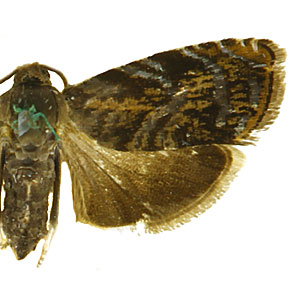Adult Recognition

FWL: 4.0-5.5 mm
Forewing pattern is distinctive with pale-yellow costal strigulae, silvery striae, a line of yellow scales preceeding the black terminal line, and a well-developed ocellus with 3-4 black dashes. The male valva is characterized by the angular apex and evenly rounded anal angle of the cucullus. Female genitalia are characterized by a ringlike sterigma with weakly sclerotized lateral extensions.
This is one of the smallest North American tortricids. Fresh specimens are unlikely to be confused with any other species; worn specimens can be dissected to confirm identity.
Larval Morphology

Late instar larvae are approximately 7.5-9.5 mm in length with a pale-reddish abdomen. The head is yellowish brown with darker mottling. The prothoracic and anal shields are brown; the prothoracic shield may have some dark posterolateral markings. Pinacular are moderately large. An anal comb is present with 4-6 teeth.
Larvae may appear similar to those of many other species of Grapholita and Cydia. Cydia pomonella larvae can be separated from G. prunivora by the absence of an anal fork and their larger size. Larvae of Grapholita molesta are similar but generally larger. Larvae of G. packardi and G. prunivora are very similar, although the pinacula on the 8th and 9th abdominal segment are more prominent in G. packardi, and the abdomen of G. prunivora is more reddish, especially in preserved specimens.
Biology

Grapholita prunivora completes two annual generations over much of its range. Adults are present in May to June and again in August.
Females lay eggs singly on young fruits or on the upper surface of leaves. Lavae tunnel into the fruit at the calyx end and feed inside. In apple, larvae may feed directly under the skin of the fruit, creating a blotchy mine. Overwintering occurs as a mature larva and pupation occurs in the spring.
Host plants
In addition to feeding on various stone-fruits, larvae of G. prunivora have also been recorded feeding inside galls.
| Family | Genus/species | Common name |
| Rosaceae | Amelanchier Medik. | serviceberry |
| Rosaceae | Crataegus L. | hawthorn |
| Rosaceae | Malus Mill. | apple |
| Rosaceae | Photinia Lindl. | chokeberry |
| Rosaceae | Prunus L. | [various] |
| Rosaceae | Prunus pensylvanica L. f. | pin cherry |
| Rosaceae | Prunus persica (L.) Batsch | peach |
| Rosaceae | Prunus salicina Lindl. | Japanese plum |
| Rosaceae | Pyrus communis L. | common pear |
Distribution

Grapholita prunivora is found throughout southern Canada and the continental U.S.; it is absent from the far South.
References

Chapman, P. J. and S. E. Lienk. 1971. Tortricid fauna of apple in New York (Lepidoptera: Tortricidae); including an account of apple's occurrence in the state, especially as a naturalized plant. Spec. Publ. Geneva, NY: New York State Agricultural Experiment Station. 122 pp.
Gilligan, T. M., D. J. Wright and L. D. Gibson. 2008. Olethreutine moths of the midwestern United States, an identification guide. Ohio Biological Survey, Columbus, Ohio. 334 pp.
Heinrich, C. 1926. Revision of the North American moths of the subfamilies Laspeyresiinae and Olethreutinae. Bulletin of the U.S. National Museum. 132: 1-216.
Komai, F. 1999. A taxonomic review of the genus Grapholita and allied genera (Lepidoptera: Tortricidae) in the Palaearctic region. Entomologica Scandinavica Supplement 55. 226 pp.
MacKay, M. R. 1959. Larvae of the North American Olethreutidae (Lepidoptera). Canadian Entomologist Supplement 10: 1-338.
Weires, R. and H. Riedel. 1991. Other tortricids on pome and stone fruits, North American species, pp. 313-434. In: L. P. S. van der Geest, H. H. Evenhuis (eds.), Tortricid pests, their biology, natural enemies and control. Elsevier, Amsterdam, The Netherlands.
Photo Credits

Fig. 5: P. J. Chapman, New York State Agricultural Experiment Station, Bugwood.org

